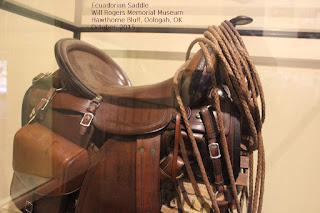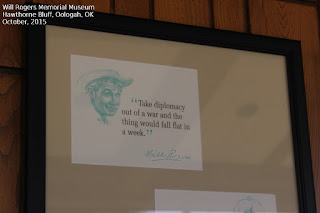Out drive to Oologah wasn't
particularly riveting, but there was always something interesting to
see, even if it was just the names of towns we passed: Nowata,
Talala, Hominy, and Broken Arrow. There were yards that boasted
tornado shelters, and we scored another crack in the windshield. Just
like the TV ad, SafeLite fixed it with neither hassle nor additional
cost to us. We passed oil pump jacks, lots of pastures with horses
and cattle herds, (the horses nearly always had several donkeys with
them). We were still in the high plains and had a nearly constant 20
wind.
This park was beautiful, with many
sites were on the water. In spite of being near a large power plant,
the noise wasn't more than a continuous drone and hardly noticed it
after a while.
We spent some time at Will Rogers'
birthplace (yes, on some of the photos, I got the ' in the wrong
place and was too lazy to resize the photos again, my bad) the Dog
Iron Ranch near Oologah and the Will Rogers Memorial Museum in
Claremore. The ranch was established in Indian Territory's Cherokee
Nation in 1870. Will, part Indian and the last of eight children, was
born in 1879. He wrote his first newspaper article in 1903, was
syndicated from 1916 to 1933, and came to be the most influential
newspaper columnist of his day, appearing in a record of 300
newspapers and reaching 40 million readers. As if that wasn't enough,
the humorist-philosopher was a star of Ziegfield Follies and 71
motion pictures, author of seven books, and America's first radio
commentator. His credo was “I never met a man I didn't like.”
The Will Rogers Memorial Museum was the
polar opposite of the cozy “little white house on the verdigris”
where Will was born. The imposing yet beautiful stone, wood, and
glass building sat atop a knoll overlooking Claremore amidst
beautifully kept gardens. Inside were displays housing Nicaraguan,
Western, Charro, Ecuadorian, Mongolian, Navajo, and French saddles.
Sculptures by Remington and Russell graced displays near sketches and
paintings of Will by American artist Charles Banks Wilson. Dioramas
depicting scenes from Will's stint as a cowboy, Claremore in 1895,
the Ziegfield Follies, and other important times in his life merited
a room of their own, as did a collection of his movie posters where
his old movies were shown continuously. Of course, one wall was
covered with his quotes, which are as pertinent today as the day he
wrote them:
“That's one trouble with our
charities, we are always saving somebody way off when the fellow next
to us ain't eating.”
“It's awful hard to get people
interested in corruption unless they can get some of it.”
“With Congress, every time they make
a joke, it's a law. Every time they make a law, it's a joke.”
And one of my favorites, “Live your
life so that whenever you lose, you are ahead.”
We enjoyed both of these museums, saw
some beautiful displays, enjoyed some movies, and gained appreciation
for a very special man.
We drove into Tulsa for the Air and
Space Museum and I guess after having gone through the Naval Air
Museum in Pensacola, I've got overly high expectations. We were
surprised that even with a major airline as a sponsor, the museum
didn't have more depth and wasn't a bit more polished. There were
some beautiful old planes, but most of the information and displays
focused on the Spartan company which was located in Tulsa. We had
lunch at White River Fish Market, which was touted as the best place
to eat for miles by locals, had an extensive menu, but we were sorely
disappointed. We had four different waiters bring us bits of our
meal, then had to wait for them to bring the fish Rich had ordered.
By the time he got the fish, the rest of his meal was cold.
All-in-all, our day in Tulsa was a dud. The next day we did, however,
score a great meal at Ted's Cafe Escondido in Broken Arrow, OK, which
was worth writing home about. That's on our list of places to go
again, but we'll steer clear of the fish market!
Next stop is Russellville, Arkansas..















































































